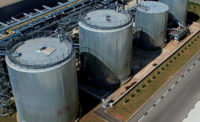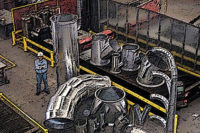While both belt and direct drive fans have been around for a long time, the mainstay fan for most industrial fan applications under 250 hp has been the belt drive fan. With the growing acceptance and affordability of VFD motor controllers, direct drive fans are increasingly finding their way into mainstream industrial fan applications. This article provides a non-exhaustive overview of belt and direct drive fans for industrial fan applications between 1-250 hp.
Installation Footprint
Belt Drive Fans — Arrangements 1, 9, and 10 are the most common belt drive fan configurations. Arrangements 9 and 10 provide the most compact footprint, as the motor is installed either on the external side of the fan bearing pedestal (Arr. 9) or inside the cavity of the fan bearing pedestal (Arr. 10). Arrangement 9 and 10 fans are often limited to lower capacity horsepower applications with upper limits of 75-100 hp for Arrangement 9 fans and 40 hp for Arrangement 10 fans. Arrangement 1 fans are often selected up to about 250 hp but at the expense of a larger footprint.
Direct Drive Fans — Arrangements 4, 7, and 8 are the most common direct drive fan configurations. Arrangement 4 is the most compact footprint, with the motor installed directly onto the fan pedestal. Arrangements 7 and 8 use the fan shaft and bearing design found on belt drive fans — except instead of connecting the motor to the fan shaft via a belt drive, the fan shaft is connected in-line to the motor shaft using a flexible drive coupling. There is no defined limit on motor horsepower for direct drive fans, which allow a wide range of flexibility for application requirements.
Direct drive fans configure the overall fan and motor assembly in a narrower, more straight-line footprint than belt drive fans, which tend to have shorter and wider footprints. Installation spaces having limited width and available length favor direct drive fans, while installation spaces having available width and limited length typically favor belt drive fans. Arrangement 4 direct drive fans will always be the most compact fan selection.
Airstream Conditions
Airstream conditions should be considered when choosing between an Arrangement 4 fan and a shaft driven belt or direct drive fan. Due to the presence of the motor shaft in the airstream, Arrangement 4 fans are best suited for relatively clean airstreams having little to no moisture and low particulate concentrations. Shaft driven belt or direct drive fans are well suited for clean or contaminated airstreams that have higher particulate loadings, gases, vapors, or chemical compositions that might attack the exposed motor shaft on Arrangement 4 fans.
 > FIGURE 1. From top left: Arr. 1 belt drive fan; top middle: Arr. 9 belt drive fan; top right: Arr. 10 belt drive fan. From bottom left: Arr. 4 direct drive fan; bottom middle: Arr. 7 direct drive fan; bottom right: Arr. 8 direct drive fan. Images courtesy of New York Blower Company.
> FIGURE 1. From top left: Arr. 1 belt drive fan; top middle: Arr. 9 belt drive fan; top right: Arr. 10 belt drive fan. From bottom left: Arr. 4 direct drive fan; bottom middle: Arr. 7 direct drive fan; bottom right: Arr. 8 direct drive fan. Images courtesy of New York Blower Company.
Due to the wheel being installed directly onto the motor shaft, Arrangement 4 fans are difficult to fit with contact-type shaft seals to isolate the airstream within the fan housing. This can allow exposure of the airstream to the motor drive end bearing and potential motor drive end bearing failure.
For airstream conditions hostile to Arrangement 4 fans, a shaft driven direct or belt drive fan is the recommended choice. Shaft driven fans can be fitted with shafting materials and shaft seals that are compatible to the airstream conditions at a lower cost than modifying an Arrangement 4 fan.
Installation Location
The environmental conditions in which the fan is installed may dictate a preference toward a belt or direct drive fan. Extreme hot, cold, dirty, or humid conditions may favor a direct drive fan as it reduces the environmental impact on the drive belts and fan bearings. Fans installed on the top of heat-generating equipment, such as furnaces or dryers, or those located in limited maintenance access areas, may also favor the direct drive fan. Figure 2-A shows a belt drive fan installed in a dust-laden environment that can attack the belt and bearing life. Figure 2-B shows a belt drive fan installed at the upper section of a silo having limited maintenance access to service the belts and bearings.
 > FIGURE 2-A
> FIGURE 2-A
 > FIGURE 2-B
> FIGURE 2-B
Fan Noise
Fan noise is a type of unwanted sound from the fan and can either be aerodynamic or mechanical. Aerodynamic noise varies with fan efficiency, while mechanical noise varies with the mechanical components used to drive the fan. Mechanical components having the greatest impact on fan noise are the fan bearings and v-belt drive. In noise-sensitive applications, Arrangement 4 fans will have the lowest and most easily controlled mechanical noise, followed by Arrangement 7 and 8 direct drive fans. Belt drive fans can be successfully applied if the mechanical noise can be abated by a partial or full noise enclosure around the fan.
Direct Drive In-line Fans
Direct drive in-line fans are Arrangement 4 fans in which the motor is installed inside the fan housing or frame such that the motor is in the airstream. In these cases not only must the motor be suitable for the airstream conditions, but the motor noise is added to the fan aerodynamic noise and motor heat load is added to the airstream. Normally, these are not big issues, but in applications having strict limits for aerodynamic noise or temperature control, a belt drive fan may be the better choice.
Maintenance
In virtually every case, direct drive fans are more maintenance-friendly than belt drive fans. For Arrangement 4 fans, this is due to the absence of fan bearings and v-belt drives. For Arrangement 7 and 8 fans this is due to the absence of a v-belt drive. Fan bearing and drive tensioning check schedules vary and should be followed according to the manufacturer’s guidelines. Typically, fan bearings should be lubricated at one- to four-month intervals, and drive tensioning should be checked three to four times each year.
 > FIGURE 3 Arr 4 direct drive in-line fan. Image courtesy New York Blower Company.
> FIGURE 3 Arr 4 direct drive in-line fan. Image courtesy New York Blower Company.
 > FIGURE 4 Belt drive bearing fan
> FIGURE 4 Belt drive bearing fan
Other advantages include easier monitoring of bearing vibration and/or temperature on Arrangement 4 fans and lower overall vibration levels due to fewer rotating parts.
Figure 4 shows a fan bearing failure on a fan that was installed on the upper level of a mezzanine in a difficult maintenance access area.
Another feature of Arrangement 4 fans is the ability for the fan manufacturer to build the motor and wheel as a pre-assembled, replaceable, plug-type assembly. In this case, instead of changing out a failed motor or wheel in situ, a spare motor-wheel unit is kept in stock and replaced as a pre-assembled unit, allowing the repair to either the failed motor or wheel to occur at a more convenient schedule. This does require the fan housing to be constructed with either a housing split or a removable plug section on the housing drive side.
Fan Speed
By nature of the ease of configuring v-belt drive components (sheaves and belts), belt drive fans offer a wide flexibility in fan speed ranges when operating with a fixed-speed motor. However, with the continued affordability and acceptance of electronically commutated motors (ECMs) and VFD controllers, direct drive fans are becoming much more popular. Note that since ECMs are normally less than 7.5 hp and often single phase, the following comments will be for VFD driven fans.
Motors driven by VFDs are typically either 60 Hz and 3,600, 1,800, 1,200, or 900 rpm or 50 Hz and 3,000, 1,500, 1,000, or 750 rpm. Since, by design, direct driven fans operate at the motor speed, VFDs allow the fan speed to be varied by using the VFD for changing the motor speed.
Normally, this means using the VFD to reduce the motor speed from its rated nameplate rpm, but in some cases it is allowable to over-drive the motor speed in order to run the fan at a higher speed. In all over-drive cases, the fan hp demand (load) cannot exceed the listed motor nameplate hp. While it is becoming acceptable to run an over-drive of up to 1.5 times the motor nameplate rpm for motors under 40 hp, it is recommended to gain motor and drive manufacturer’s approval for any over-drive application, especially for higher horsepower applications.
Regarding fan speed turn-downs lower than the motor nameplate rpm, most motors are suitable for turn-down ratios ranging 6:1-10:1. This allows a wide range of flexibility in fan speed turn-down, but keep in mind that at sustained operation at very low turn-downs, fan cooled motors may not generate enough cooling to satisfy the motor heat load. Check with your motor supplier if in doubt.
 > TABLE 1.
> TABLE 1.
While v-belt drive changes are easily accomplished at the job site, constant-speed v-belt drive speed selections are limited to the range of sheave sizes manufactured by the drive industry. This means that a target fan speed may or may not be achieved by a v-belt drive but can be achieved by a VFD driven belt or direct drive fan, as the VFD controller allows for small increments in speed change. Adjustable speed v-belt drives do offer greater flexibility than constant speed v-belt drives but are often limited to 40-hp-and-lower applications.
When a VFD controller is used to control the fan speed, the fan maximum safe speed must be determined to ensure the VFD does not drive the fan beyond its maximum safe speed. In cases where the fan maximum safe speed is below the upper range of the VFD controller, the VFD must be configured to lock out speed ranges above the fan maximum safe speed. For example, if the design fan speed is 1,440 rpm (48 Hz), the maximum safe speed of the fan is 1,620 rpm (54 hz), and a 1,800 rpm motor is used, then the VFD must be configured to lock out running frequencies above 54 Hz.
If multiple fans are installed in a common location (mezzanine, dryer, etc.) in close proximity to each other and running at the same design speed, a beat frequency can occur from the fans running in the same cycle. In these cases, a VFD controller can be used with either direct or belt drive fans to avoid this problem by varying the speeds of adjacent fans while still maintaining the same overall system flowrate.
AMCA-certified Fans
For fans that are AMCA certified for air or sound performance, the AMCA certification may not carry over to direct drive fans. It is common to “tune” a direct drive fan selection to achieve optimum efficiency or a target position on the fan curve using not only speed control but also by changing the fan wheel geometry (width or diameter). AMCA certification is for a fixed wheel geometry (100 percent width and 100 percent diameter), and when the wheel geometry is changed, the AMCA certification does not transfer due to the change in geometric similarity of the fan wheel. In cases in which the requirement for AMCA certification is absolute, check with your fan manufacturer for the final determination.
Drive Efficiency
AMCA Publication 203-90 (R2011), Figure L.1, provides the most accurate estimation of v-belt drive losses from 0.3-600 operating horsepower. For 1 hp, the estimated v-belt drive loss ranges from about 6-15 percent, for 20 hp about 3-7 percent, and for 200 hp about 3-6 percent. Since there is at least a 3 percent drive loss for a belt drive fan and no v-belt drive loss for a direct drive fan, the direct drive fan, by default, will be more efficient. Note that for shaft driven direct drive fans (Arr. 7, 8, etc.), the flexible drive coupling loss is immeasurable and ignored, so its drive efficiency follows that of an Arr. 4 direct drive fan.
Motor hp Selection
While a properly selected VFD driven direct drive fan will normally operate at or near the efficiency of a belt drive fan, there are occasions where the motor hp selection is higher for the direct drive fan than the belt drive fan. In these cases, the user must weigh first cost against efficiency savings.
 > FIGURE 5.
> FIGURE 5.
 > FIGURE 5. Image courtesy of New York Blower Company
> FIGURE 5. Image courtesy of New York Blower Company
Example: Fan selection at 14,000 cfm @ 12-inch wg fan static pressure and 0.075 lbs./cu. ft. inlet density
The following data shows a selection between size 24 and 27 fans.
Examining the data, while power and efficiency slightly favors the size 27, its point of operation is near the peak of the fan curve, and caution must be exercised in order to keep the fan system from operating at or left of the peak of the fan curve.
Further, as a direct drive fan, the size 27 would have to be over-driven to about 78 Hz using a 1,800 rpm motor while the size 24 would be under-driven to about 47 Hz using a 3,600 rpm motor. Given that the size 24 operates at a more desirable point on the fan curve and at a direct drive speed that more easily allows for increased capacity, the size 24 fan is selected for the application.
For the size 24 direct drive fan, the fan shaft horsepower, which must be produced by the motor, is 35 at 2,794 rpm. When driven by a VFD, motor power output will vary either with the square of the change in motor rpm (squared volts to hz ratio) or directly with the change in motor rpm (linear volts to hz ratio).
Since fans are variable load machines with power varying with the cube of the change in speed, the highest efficiency is to operate the VFD in the squared volts to hz ratio as it most closely mimics the fan speed to power curve. But it’s not uncommon to use the linear ratio as the actual difference in efficiency is often very small.
Using the following formulas to calculate fan motor horsepower selection, we find that:
To operate the motor in the VFD squared volts to hertz ratio configuration:
(Motor Nameplate RPM ÷ Fan RPM)2 (Fan hp) = (3600 ÷ 2794)2 (35) = 58.1 hp
To operate the motor in the VFD linear volts to hertz ratio configuration,
(Motor Nameplate RPM ÷ Fan RPM) (Fan hp) = (3600 ÷ 2794) (35) = 45.1 hp
Selecting a motor for the size 24 direct drive fan based on the squared volts to hz ratio means that we need a 58.1 hp motor, so a 60 hp motor is required.
Selecting a motor for the size 24 direct drive fan based on the linear volts to hz ratio means that we need a 45.1 hp motor, so a 50 hp motor is required.
Summary
There are a number of variables to consider when choosing between a belt drive and a direct drive fan. The final decision should always be weighted based on the variables that are most important to the specific application.




